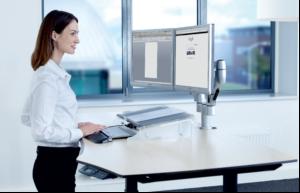If you're arguing the case for ergonomics projects in the workplace,
identifying the culture within your organisation is the first step to
achieving success, says Guy Osmond from Osmond Ergonomics
If you're arguing the case for ergonomics projects in the workplace,
identifying the culture within your organisation is the first step to
achieving success, says Guy Osmond from Osmond Ergonomics
It seems to me there are two ways of
thinking about the funding of
workplace ergonomics and it is
essential to identify which of the two
applies to your employer or client.
Unless you do so, you may be wasting
time and energy by approaching issues
the wrong way.
'Compliance Mode' applies to
organisations that accept their obligations
but are not motivated to spend beyond
the demands of minimum compliance.
They will do what they must to remain
within the law but regard these
commitments simply as unavoidable. The
way we all respond to unavoidable costs
is to make every effort to minimise them.
By contrast, 'Investment Mode' applies
to organisations which regard ergonomics
programmes as investments in the
business. Their approach recognises that
investing in the education, comfort,
posture, health and fitness of the
workforce will result in improved
productivity to the benefit of the whole
business. Their focus will be to identify
the return on that investment. Clearly,
these two modes are not absolutes and
commercial pressures and available
resources will also impact upon how an
employer responds to any individual
project. However, my experience is that
there will be an overriding culture within
an organisation that will generally lean in
one of these two directions which are, by
definition, divergent views.
It is equally important to understand
whether employees in the business
actually share the organisational culture as
it is publicly portrayed. If employees sneer
at corporate initiative posters or make
comments such as "they say that but …"
about declared organisational intentions,
there is clearly misalignment.
'Engagement' is a word that frequently
appears in discussions about getting buyin
for ergonomics, health and safety or
wellbeing programmes and the level of
staff engagement is frequently a good
indicator about the organisational culture.
If personnel genuinely believe that their
employer cares about their wellbeing,
they probably work for an Investment
Mode employer.
Dealing with Compliance Mode
employers is a simple, if unfulfilling,
process. Conversations will be short-term
by nature and the focus is on price. Such
organisations are not interested in
medium-term returns and will, typically,
buy a cheaper product even if it will have
a disproportionately short life expectancy.
Personnel in such organisations frequently
do not see their own future in the
business as long-term and, as such, are
not concerned about considering the
impact of a project too far into the future.
Investment Mode organisations are
much more rewarding to work with but
project acceptance should still not be
taken for granted. It is important to be
properly prepared and ensure proposals
are suitably focused.
Points to consider
Do your research. Ensure that you
understand the objectives of the project
and ensure your proposal matches
them. For example, if you are trying to
improve the ergonomics of homeworkers,
is the question about the
furniture or laptop use or the need to
carry equipment around? (It's probably
all three!). Remote working also raises
major communication and training
issues so it is important, not just to
provide the right equipment, but to
demonstrate how training and
monitoring can be implemented.
Do not ignore the ancillary
considerations. How important is the
look of the product? If the project
relates to a new, state-of-the-art
building, how will your proposal fit into
the surroundings? Often the
adjustability and personalisation
espoused by ergonomics may conflict
with the architect's vision.
Are there other areas of the business
where cost savings could be made as a
result of this project? For instance,
buying laptop stands with a keyboard
and mouse may save the purchase of
docking stations and/or extension
monitors.
Are there other ongoing projects or
issues that this project would support?
What are the priorities of the
occupational health or wellbeing teams
at the moment? Speak to these
departments as well as HR and IT in
case there are mutual benefits.
Are there any other current initiatives
that can be aligned to the project brief?
Is absenteeism, presenteeism or
employee fitness a current focus? How
might your project help to improve
these?
Are there any broader corporate
objectives that you can include in your
proposal? For example, what is the
organisation's position on
sustainability? Often products
promoted by ergonomics companies
have a good environmental story that
will align strongly with the corporate
philosophy of an Investment Mode
employer.
Finally, ensure you present a coherent
financial case. Remember that it's the
return on the investment that will
ultimately win the argument.
Guy Osmond is managing director of
Osmond Ergonomics


